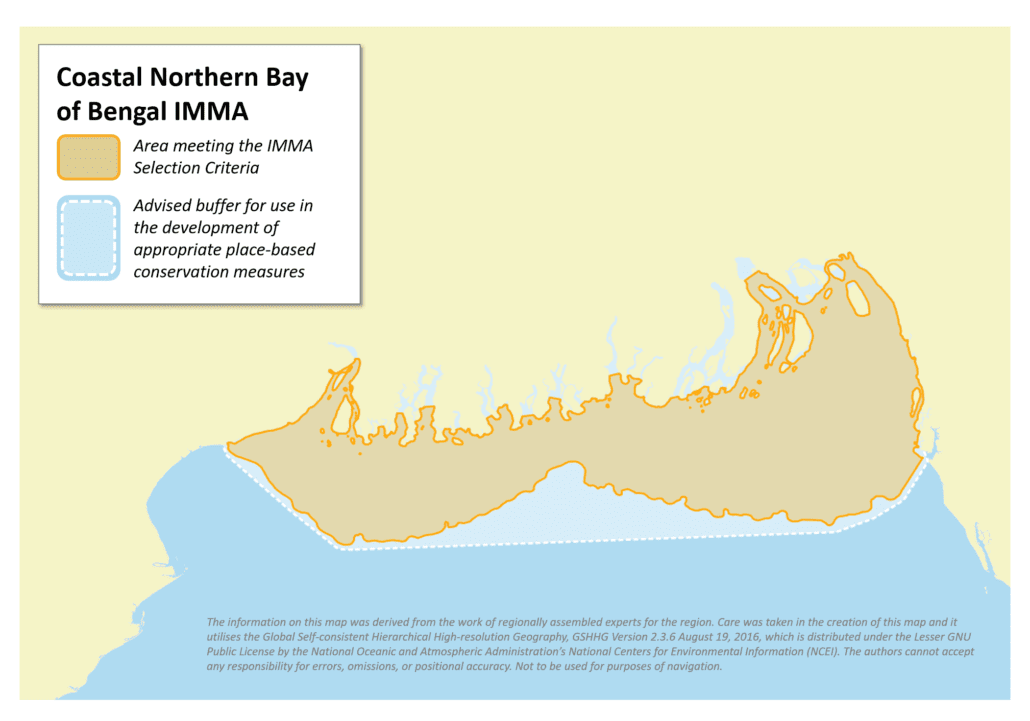Coastal Northern Bay of Bengal IMMA
Size in Square Kilometres
40 112 km2
Qualifying Species and Criteria
Irrawaddy dolphin – Orcaella brevirostris
Criterion A; B (2); C (1)
Indo-Pacific finless porpoise – Neophocaena phocaenoides
Criterion A; B (2); C (1)
Indo-Pacific humpback dolphin – Sousa chinensis
Criterion A; B (2); C (1); D (1)
Marine Mammal Diversity
Balaenoptera edeni, Tursiops aduncus
Download fact sheet
Summary
The IMMA in coastal waters of the northern Bay of Bengal is located at the outflow of world’s third largest river system, fed by biological production in the world’s largest mangrove forest, and includes a seasonally reversing current gyre with associated eddies. These oceanographic conditions combine to support threatened cetaceans in numbers generally much higher than in other coastal waters where the same species occur in the Indo-Pacific. Threatened species present in globally significant numbers include Endangered Irrawaddy dolphins and Vulnerable Indo-Pacific humpback dolphins and finless porpoises. Recent genetic studies indicate that humpback dolphins inhabiting the IMMA are genetically distinct from neighbouring populations to the east and west.
Description of Qualifying Criteria
Criterion A – Species or Population Vulnerability
The IMMA supports the world’s largest locally occurring population of Irrawaddy dolphins. This species was up listed as Endangered on the IUCN Red Listed of Threatened Species in 2017, due to a suspected population size reduction of ≥50% over the past 60 years, future 60 years, and encompassing 60 years in both the past and future (Minton et al. 2017). The IMMA also supports among the world’s largest populations of Indo-Pacific finless porpoise and Indo-Pacific humpback dolphins. Both of these species are considered Vulnerable due to a suspected or inferred decline of at least 30% over the last three generations, over three generations into the future, and over a three-generation period that includes both the past and the future (Jefferson et al. 2017, Wang and Reeves, 2017). For all three species, the factor most responsible for population declines is incidental mortality in fisheries. This means that, even though all three populations are relatively large, mortality from entanglements in fisheries and suspected declines make them vulnerable to extinction, thereby meeting Criterion A.
Criterion B: Distribution and Abundance
Sub-criterion B2: Aggregations
Extraordinary bio-productivity, driven by the enormous discharge from the Ganges/Brahmaputra/Meghna river system, redistribution and retention of nutrients in a basin-scale current gyre and upwelling in a submarine canyon, supports among the world’s largest resident populations of three globally threatened species. This gives aggregations of all three primary species occurring in the IMMA vital importance as a potential safety net to safeguard species extinction.
Criterion C: Key Life Cycle Activities
Sub-criterion C1: Reproductive Areas
Frequent sightings of Irrawaddy and Indo-Pacific humpback dolphin calves in the IMMA combined with their relative high population size implies that the area plays a particularly important role in the reproduction of these species. The cryptic nature of finless porpoises means that calves are rarely identified in the field but the high concentration of these animals in the northern Bay of Bengal surrounded to the east and west by waters that support much lower densities implies that the IMMA also has a significant role as a reproductive area for this species.
Criterion D: Special Attributes
Sub-criterion D1: Distinctiveness
Humpback dolphins in the IMMA are phylogenetically unique from neighboring populations to the east and west. Levels of genetic divergence indicate that humpback dolphins in the IMMA are as different from the other putative Sousa species as they are from each other. The productive ecological conditions in the northern Bay of Bengal may almost certainly explain the genetic distinctiveness of humpback dolphins in these waters (Amaral et al. 2016).
Supporting Information
Amaral, A.R., Smith, B.D., Mansur, R.M., Brownell, R.L. and Rosenbaum, H.C. 2017. Oceanographic drivers of population differentiation in Indo-Pacific bottlenose (Tursiops aduncus) and humpback (Sousa spp.) dolphins of the northern Bay of Bengal’. Conservation Genetics, 18(2): 371-381.
Jefferson, T.A., Smith, B.D., Braulik, G.T. and Perrin, W. 2017. Sousa chinensis (errata version published in 2018). The IUCN Red List of Threatened Species 2017: e.T82031425A123794774.
Kabir, D.S., Muzaffar, S.B., Devnath, R.K. and Haque, M.M. 2004. The state of biodiversity in the Eastern Coast of Bangladesh’. In: Proceeding of coastal wetlands in Bangladesh: Nature, livelihoods and participation held in Cox’s Bazar and organized by Bangladesh POUSH on 14th February. 7-9.
Kottke, B., Schwenk, T., Breitzke, M., Wiedicke, M., Kudrass, H.R. and Spiess, V. 2003. Acoustic facies and depositional processes in the upper submarine canyon Swatch-of-No- Ground (Bay of Bengal). Deep Sea Research Part II: Topical Studies in Oceanography, 50(5): 979-1001.
Milliman, J.D. and Syvitski, P.M. 1992. Geomorphic/tectonic control of sediment discharge to the ocean. J. Geology 100: 524-44.
Minton, G., Smith, B.D., Braulik, G.T., Kreb, D., Sutaria, D. and Reeves, R. 2017. Orcaella brevirostris (errata version published in 2018). The IUCN Red List of Threatened Species 2017: e.T15419A123790805 http://dx.doi.org/10.2305/IUCN.UK.2017-3.RLTS.T15419A50367860.en
Sarin, M.M., Krishnaswami, S., Dilli, K., Somayajulu, B.L.Y. and Moore, W.S. 1989. Major ion chemistry of the Ganges-Brahmaputra river system: weathering processes and fluxes to the Bay of Bengal. Geochim. Cosmochim Acta 53: 997-1009.
Shiklomanov, I.A. 1993. World freshwater resources. pp.13-24. In: Gleick, P. (ed). Water in Crises, a Guide to the World’s Freshwater Resources. Oxford University Press, New York. 473 pp.
Smith, B.D., Ahmed, B., Mowgli, R.M. and Strindberg, S., 2008. Species occurrence and distributional ecology of nearshore cetaceans in the Bay of Bengal, Bangladesh, with abundance estimates for Irrawaddy dolphins Orcaella brevirostris and finless porpoises Neophocaena phocaenoides. J. Cetacean Res. Manage, 10(1): 45-58.
Smith, B.D., Mansur, R.M., Strindberg, S., Redfern, J. and Moore, T. 2015. Population demographics, habitat selection, and a spatial and photographic analysis of bycatch risk of Indo-Pacific humpback dolphins Sousa chinensis and bottlenose dolphins Tursiops aduncus in the northern Bay of Bengal. International Whaling Commission Scientific Committee Report. 30 pp.
Wang, J.Y. and Reeves, R. 2017. Neophocaena phocaenoides. The IUCN Red List of Threatened Species 2017: e.T198920A50386795.


